They crossed a line. They did something outrageous and they knew it.
On October 14 2022, two young activists threw tomato soup at Van Gogh’s painting, Sunflowers, in the National Gallery of London. Gasps of horror were heard across the room as the liquid splashed onto the glass. The girl with fuchsia hair and pierced nose, trembled as she took a stick of superglue out of her bag, with her partner following closely behind. Her hands shook so violently that she struggled to take the cap off. She knew that the world would be watching. She had just tainted one of the most famous art pieces in the world, one of great significance to our heritage. Her actions would be forever attached to the painting’s memory. And she was terrified.
She slathered the glue onto the palm of her hand and slapped it onto the wall behind her. Proudly displaying a “Just Stop Oil” T-shirt, she roared:
“What is worth more—art or life? Is it worth more than food? Worth more than justice? Are you more concerned about the protection of a painting, or the protection of our planet and people? The cost-of-living crisis is part of the cost-of-oil crisis. Fuel is unaffordable to millions of cold, hungry families. They can’t even afford to heat a tin of soup. Meanwhile, crops are failing. Millions of people are dying in monsoons, wildfires and severe droughts. We cannot afford new oil and gas. It is going to take everything we know and love.”
Her voice cracked as she said the words. In her eyes you could see her desperation. The responsibility of carrying that message outweighed her fear of punishment. So she pushed on.
These are the feelings that the climate crisis should evoke: desperation, empathy, and responsibility. But unfortunately, like Van Gogh’s Sunflowers, it remains in the background as the world melts and drips off its frame.
Activism: a necessary disruption

Just Stop Oil handout / EPA, CC BY-NC
The event was quickly portrayed as vandalism by media outlets who focused solely on the impacts on the painting. Outrage was widespread and directed not only at the two activists, but at a whole generation trying to provoke a response to climate change. In times when the habitability of our planet hangs by a thread, dismissing the actions of activists that seek to shine light on the urgency of the issue seems like a lazy, shortsighted attempt to avoid recognizing our failures in dealing with it.
Focusing on the tactics of environmental activism is a good way of hijacking the conversation and avoiding talking about an uncomfortable reality. Climate activism draws attention to the plea of climate migrants forced to flee their homes in search of basic life-sustaining resources; to the desperation of coastal communities ravaged by floods and typhoons; to the helplessness of people unable to feed their families due to drought. Recognizing and understanding this reality reveals to us the consequences of our lifestyles. It makes us question previously held beliefs of our individualism and compels us to see ourselves within a wider network of life, in which we co-exist on equal footing with people in distant countries, and with animals, plants, insects and elements, we didn't know existed. It takes a brave mind to accept our place in the world and act accordingly, in respect for our neighbors. The problem is that we have grown too comfortable with the status quo. We are content with outsourcing our responsibility to politicians, “the rich”, scientists, and others. This is why disruptive actions and activism are necessary. It offers up facts, heart-wrenching testimonies and action proposals to remind us that, despite there being different degrees of responsibility, we are all responsible for creating a healthier world.
Today, discussions on environmental activism undermine the beauty, diversity and creative power of the movement. A thought and passion can be expressed in many forms; each of different visibility, of equal importance and legitimacy. Environmental activism reveals a generation ready to take and demand ownership of the decisions that will shape their future; identifying priority issues of our communities and taking action with our capacities, interests and channels. Like the ecosystems it seeks to protect, each action within the environmental movement has its unique features and roles within the system. Each is interdependent and mutually enhancing. Associating the movement only with the more radical forms of demonstration overlooks the efforts of those who spend restless hours lobbying policy makers to achieve higher environmental protections. Volunteers who offer their time to clean our green spaces and care for our animals. Scientists and artists that use their creativity to uncover new layers of our world and convey them to the wider public. Everyone who sees the value in everyday consciousness like eliminating single-use plastic and switching to seasonale, mostly plant-based diets. A kaleidoscope of different actions, each unique and important, is needed to carry the message of environmental justice through the barrier of shallow discourses and judgment to the center of the discussion where it belongs.
What a fascinating time to live in when decisions are being influenced by young people with fantasy-colored hair, tattoos and piercings. What a fascinating generation to be a part of where empowered, diverse and courageous activists are challenging people in power, demanding change and showing that they are not willing to wait for anyone to take action. Each of their efforts and expressions needs to be recognized, contextualized and valued, rather than taken at face-value and scrutinized.
Van Gogh’s Sunflowers has now been cleaned and is back on display; the world can breathe a sigh of relief. But the climate crisis rages on. Which is worse?
